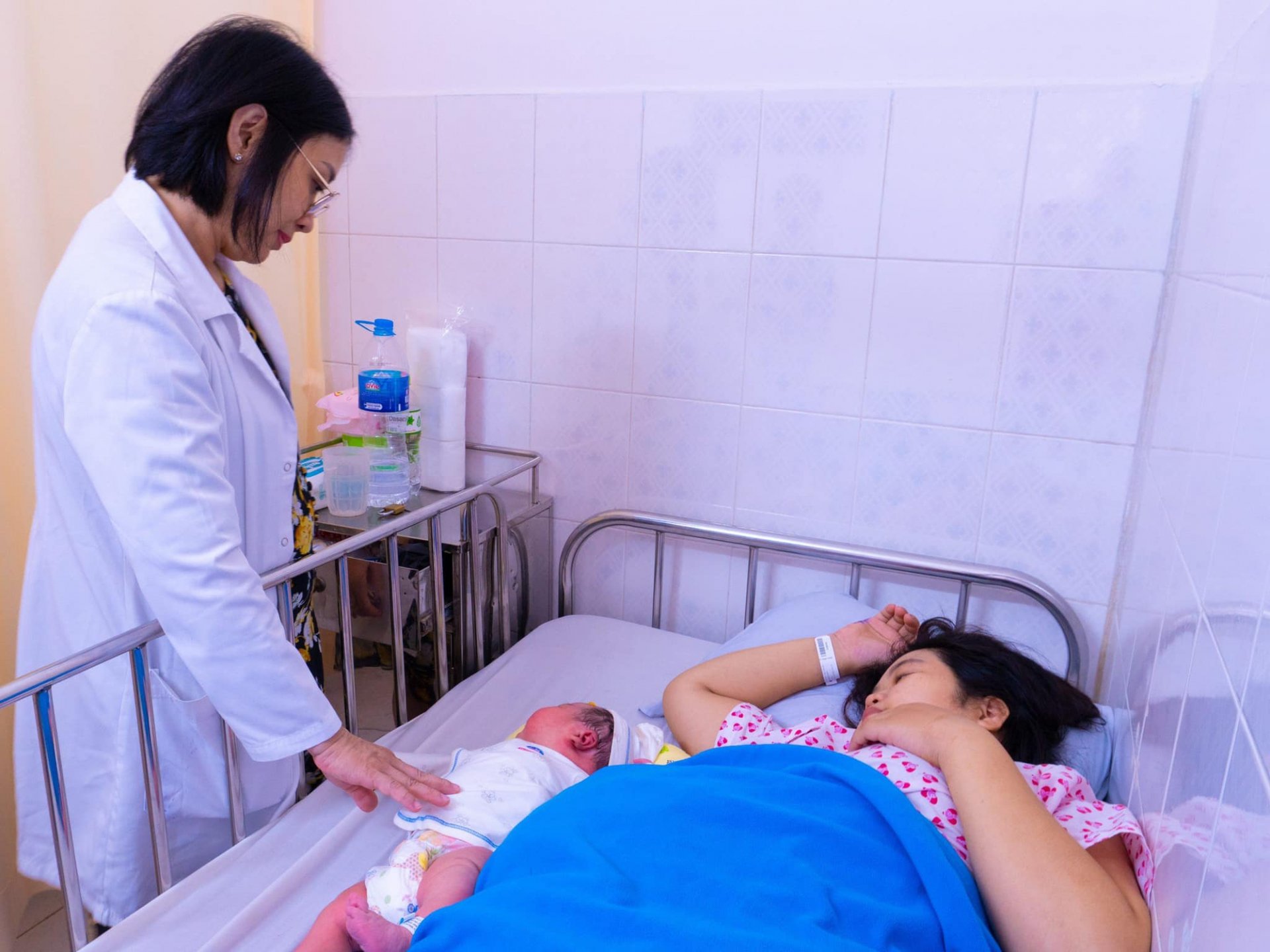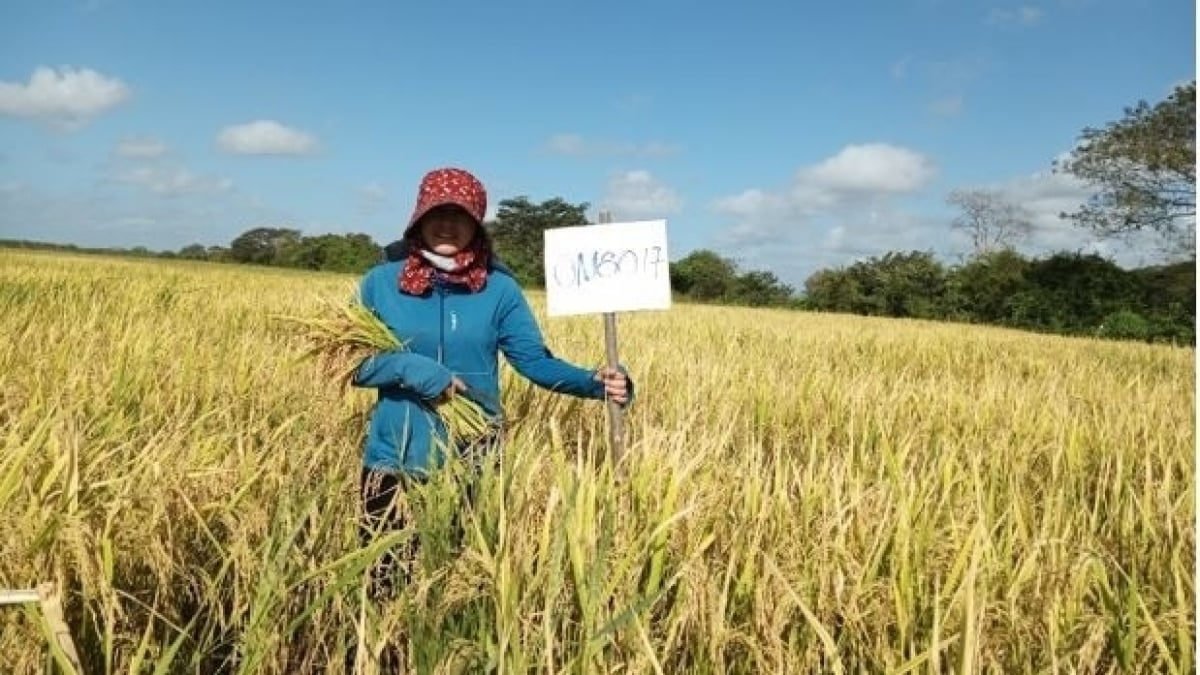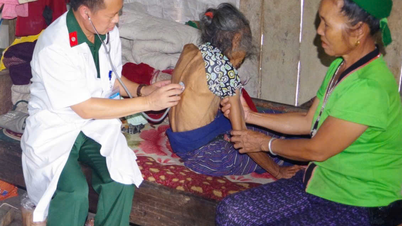Doctor examines postpartum woman at hospital. Photo: SKDS |
First child... third
Ms. Nguyen Thi Thuy in Xuan Quang 3 commune (Dong Xuan district) said that she was pregnant 4 times, but gave birth to both mother and child safely, and was only able to raise 2 children. The first child died at birth at home, the second child was born prematurely and also died...
Mr. Tran Van Nhi, also from Xuan Quang 3 commune, shared: He has 2 children born at home. When his wife had a stomachache, the family called a midwife to deliver the baby at home and bathe the baby. The first child developed normally, but when he was pregnant with the second child, the couple worked far from home on the farm. According to his wife's calculations, she would still have a week to give birth, but unexpectedly she gave birth early, and the baby was born in the farm, so she named him Cu Ray. The child named Ray was disabled and stunted.
Ms. La Lang Thi Bong in Phu Mo commune (Dong Xuan district) gave birth to her third child before she could raise it. Ms. Bong explained: The first and second children were still premature and died after being born. “I was very sad when I lost two children. When I had the third child, I went to the health station and hospital for a check-up and regular ultrasound. The doctor showed me how to walk to avoid miscarriage, thanks to that I was able to keep the third child healthy,” Ms. Bong said.
Only save mother
Ms. Kso Ho Thu in Ea Cha Rang commune (Son Hoa district) was pregnant three times and gave birth at home, raising two children. When asked why she did not go to the health station to give birth, she said: "Giving birth at home, calling a midwife is also a habit. Here, giving birth at home is common, few people go to the hospital."
During her third pregnancy, Ms. Thu also followed the habit of giving birth at home, but an accident happened. Ms. Thu had abdominal pain for 2 days but could not give birth. The situation was critical, so her family took Ms. Thu to the district medical center, where the doctor ordered an emergency cesarean section to "save the mother" because the fetus had died in her womb.
According to the Son Hoa District Medical Center, although ethnic minority mothers in mountainous districts all have health insurance cards, many still choose to give birth at home. Many people still think that going to a medical facility with an extra visitor is costly. In addition, when pregnant, women in mountainous and ethnic minority areas have little or no opportunity to have regular prenatal checkups. Because they do not have regular prenatal checkups, pregnant women do not know their due date to prepare for childbirth. Newborns are often born with a knife or scissors available at home. This custom has caused many mothers and children to die or suffer from disabilities when giving birth at home.
Ms. Huynh Thi Cuc in Hoa Vinh Ward (Dong Hoa Town) said: I have a sister who got married in Phu Quoc Island ( Kien Giang ). On the day she went into labor and had difficulty giving birth, she called home and the whole family cried. According to Ms. Cuc, after going to the doctor, the pregnancy was difficult, and the mother abandoned the baby and vice versa, so the couple sought treatment in many places, had regular check-ups to monitor the fetus. When they went into labor, the whole family held their breath waiting. Then, thanks to modern medicine, the doctor performed an emergency surgery on both mother and child, "9 parts of them died", but the result was that the mother was safe and the baby was born to the joy of many people.
Ms. Cuc added that the couple named the child Ti, because from the time of conception to birth and raising, it cost billions of dong. There is a folk saying: Having gold, gold is not good to show off/ Having a child, it is amazing to listen to. It is true that having a healthy mother and child, developing normally, is a precious gift from nature to every couple.
Maternal and child mortality rates remain high
According to statistics from the United Nations Population Fund (UNFPA), in Vietnam, although the national maternal mortality rate has decreased to 46%/100,000 live births in recent years, this number is still very high in mountainous areas and ethnic minority areas (100-150 cases/100,000 live births), especially in the midlands, northern mountainous areas and the Central Highlands.
One study found that among reported maternal deaths in mountainous areas, rates were higher among some ethnic groups, such as the Mong (60%) and Thai (17%). The risk of death during pregnancy or childbirth among Mong mothers is estimated to be four times higher than that of Kinh mothers.
The main cause of death for mothers in ethnic minority areas is giving birth at home or on the way to the hospital, accounting for 47.2%. This shows that ethnic minority mothers still have incorrect and incomplete awareness about pregnancy examination and care according to the instructions of medical staff ; delay in going to medical facilities, when the situation is critical, emergency treatment is too late.
In the coming time, the Department of Health will implement the plan of the Provincial People's Committee on people's health care, improving the health and stature of ethnic minorities in ethnic minority and mountainous areas in the three districts of Dong Xuan, Son Hoa, and Song Hinh. This plan aims to improve the capacity of population management in ethnic minority areas, organize specialized training courses on prenatal screening, newborn screening for communes, villages, hamlets, and neighborhoods, including population collaborators, village health workers, departments, and organizations at the grassroots level...
According to Phu Yen Department of Health, through checking records, books, and actual facilities and equipment at health stations, it can be seen that most commune health stations have relatively adequate facilities, have clean separate operating rooms, medicine cabinets and some equipment and tools for family planning and gynecological examination. Along with that, health stations are ready to provide full and timely family planning services, monitoring and support work is carried out quite well, information is updated into the basic health software, reporting and storing information according to regulations. However, health centers in districts, towns and cities have not yet implemented newborn screening and diagnosis, but depend on central-level prenatal and neonatal screening and diagnosis centers (Hue University of Medicine and Pharmacy, Tu Du Hospital). Therefore, activities to improve population quality, especially prenatal and neonatal screening and diagnosis, still face difficulties. Another difficulty is that pregnant women do not proactively go to medical facilities for prenatal check-ups, or do so at the wrong time during pregnancy, so it is difficult to detect birth defects. In some cases, birth defects are detected at full term.
According to Deputy Director of the Department of Health Huynh Le Xuan Bich, in the coming time, the Department of Health will implement the plan of the Provincial People's Committee on public health care, improving the physical condition and stature of ethnic minorities in ethnic minority and mountainous areas in the three districts of Dong Xuan, Son Hoa and Song Hinh. This plan aims to improve the capacity of population management in ethnic minority areas, organize specialized training courses on prenatal screening and newborn screening for communes, villages, hamlets and neighborhoods, including population collaborators, village health workers, departments and organizations at the grassroots level; district and commune levels, including: health centers, health stations and population offices...; carry out screening, diagnosis and treatment of some prenatal and neonatal diseases and disabilities. Accordingly, pregnant women are screened, diagnosed and treated for some prenatal diseases and disabilities; newborns are screened, diagnosed and treated for some congenital diseases.
Source: https://baophuyen.vn/xa-hoi/202505/nguy-hiem-sinh-con-tai-nha-fc5147c/







































































































Comment (0)